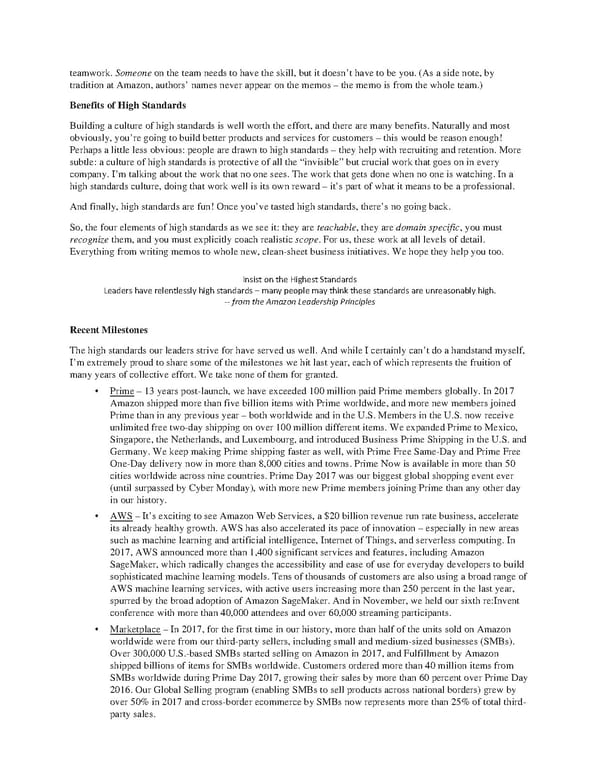teamwork. Someone on the team needs to have the skill, but it doesn’t have to be you. (As a side note, by tradition at Amazon, authors’ names never appear on the memos – the memo is from the whole team.) Benefits of High Standards Building a culture of high standards is well worth the effort, and there are many benefits. Naturally and most obviously, you’re going to build better products and services for customers – this would be reason enough! Perhaps a little less obvious: people are drawn to high standards – they help with recruiting and retention. More subtle: a culture of high standards is protective of all the “invisible” but crucial work that goes on in every company. I’m talking about the work that no one sees. The work that gets done when no one is watching. In a high standards culture, doing that work well is its own reward – it’s part of what it means to be a professional. Andfinally, high standards are fun! Once you’ve tasted high standards, there’s no going back. So, the four elements of high standards as we see it: they are teachable, they are domain specific, you must recognize them, and you must explicitly coach realistic scope. For us, these work at all levels of detail. Everything from writing memos to whole new, clean-sheet business initiatives. We hope they help you too. Insist on the Highest Standards Leaders have relentlessly high standards – many people may think these standards are unreasonably high. -- from the Amazon Leadership Principles Recent Milestones Thehighstandards our leaders strive for have served us well. And while I certainly can’t do a handstand myself, I’m extremely proud to share some of the milestones we hit last year, each of which represents the fruition of manyyears of collective effort. We take none of them for granted. • Prime – 13 years post-launch, we have exceeded 100 million paid Prime members globally. In 2017 Amazonshippedmorethanfivebillion items with Prime worldwide, and more new members joined Prime than in any previous year – both worldwide and in the U.S. Members in the U.S. now receive unlimited free two-day shipping on over 100 million different items. We expanded Prime to Mexico, Singapore, the Netherlands, and Luxembourg, and introduced Business Prime Shipping in the U.S. and Germany. WekeepmakingPrimeshippingfaster as well, with Prime Free Same-Day and Prime Free One-Daydelivery now in more than 8,000 cities and towns. Prime Now is available in more than 50 cities worldwide across nine countries. Prime Day 2017 was our biggest global shopping event ever (until surpassed by Cyber Monday), with more new Prime members joining Prime than any other day in our history. • AWS–It’sexciting to see Amazon Web Services, a $20 billion revenue run rate business, accelerate its already healthy growth. AWS has also accelerated its pace of innovation – especially in new areas such as machine learning and artificial intelligence, Internet of Things, and serverless computing. In 2017, AWSannouncedmorethan1,400significant services and features, including Amazon SageMaker, which radically changes the accessibility and ease of use for everyday developers to build sophisticated machine learning models. Tens of thousands of customers are also using a broad range of AWSmachinelearningservices, with active users increasing more than 250 percent in the last year, spurred by the broad adoption of Amazon SageMaker. And in November, we held our sixth re:Invent conference with more than 40,000 attendees and over 60,000 streaming participants. • Marketplace – In 2017, for the first time in our history, more than half of the units sold on Amazon worldwide were from our third-party sellers, including small and medium-sized businesses (SMBs). Over 300,000 U.S.-based SMBs started selling on Amazon in 2017, and Fulfillment by Amazon shipped billions of items for SMBs worldwide. Customers ordered more than 40 million items from SMBsworldwideduringPrimeDay2017,growingtheirsales bymore than 60 percent over Prime Day 2016. Our Global Selling program (enabling SMBs to sell products across national borders) grew by over 50% in 2017 and cross-border ecommerce by SMBs now represents more than 25% of total third- party sales.
 Amazon Shareholder Letters 1997-2020 Page 89 Page 91
Amazon Shareholder Letters 1997-2020 Page 89 Page 91